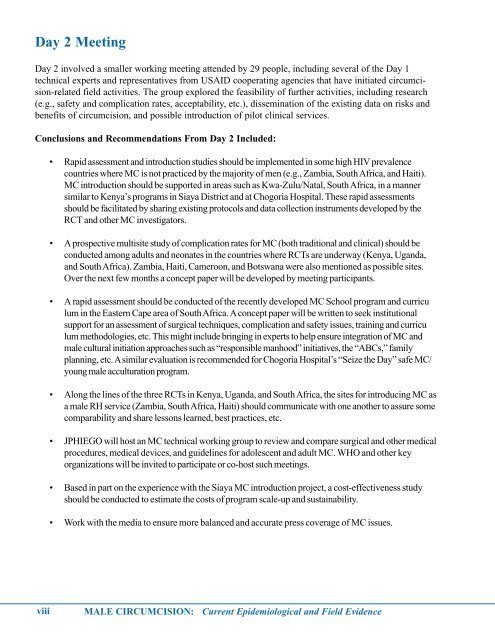Male Circumcision
Male Circumcision: Current Epidemiological and Field ... - Info Centre
Male Circumcision: Current Epidemiological and Field ... - Info Centre
Create successful ePaper yourself
Turn your PDF publications into a flip-book with our unique Google optimized e-Paper software.
Day 2 MeetingDay 2 involved a smaller working meeting attended by 29 people, including several of the Day 1technical experts and representatives from USAID cooperating agencies that have initiated circumcision-relatedfield activities. The group explored the feasibility of further activities, including research(e.g., safety and complication rates, acceptability, etc.), dissemination of the existing data on risks andbenefits of circumcision, and possible introduction of pilot clinical services.Conclusions and Recommendations From Day 2 Included:• Rapid assessment and introduction studies should be implemented in some high HIV prevalencecountries where MC is not practiced by the majority of men (e.g., Zambia, South Africa, and Haiti).MC introduction should be supported in areas such as Kwa-Zulu/Natal, South Africa, in a mannersimilar to Kenya’s programs in Siaya District and at Chogoria Hospital. These rapid assessmentsshould be facilitated by sharing existing protocols and data collection instruments developed by theRCT and other MC investigators.• A prospective multisite study of complication rates for MC (both traditional and clinical) should beconducted among adults and neonates in the countries where RCTs are underway (Kenya, Uganda,and South Africa). Zambia, Haiti, Cameroon, and Botswana were also mentioned as possible sites.Over the next few months a concept paper will be developed by meeting participants.• A rapid assessment should be conducted of the recently developed MC School program and curriculum in the Eastern Cape area of South Africa. A concept paper will be written to seek institutionalsupport for an assessment of surgical techniques, complication and safety issues, training and curriculum methodologies, etc. This might include bringing in experts to help ensure integration of MC andmale cultural initiation approaches such as “responsible manhood” initiatives, the “ABCs,” familyplanning, etc. A similar evaluation is recommended for Chogoria Hospital’s “Seize the Day” safe MC/young male acculturation program.• Along the lines of the three RCTs in Kenya, Uganda, and South Africa, the sites for introducing MC asa male RH service (Zambia, South Africa, Haiti) should communicate with one another to assure somecomparability and share lessons learned, best practices, etc.• JPHIEGO will host an MC technical working group to review and compare surgical and other medicalprocedures, medical devices, and guidelines for adolescent and adult MC. WHO and other keyorganizations will be invited to participate or co-host such meetings.• Based in part on the experience with the Siaya MC introduction project, a cost-effectiveness studyshould be conducted to estimate the costs of program scale-up and sustainability.• Work with the media to ensure more balanced and accurate press coverage of MC issues.viiiMALE CIRCUMCISION: Current Epidemiological and Field Evidence

















